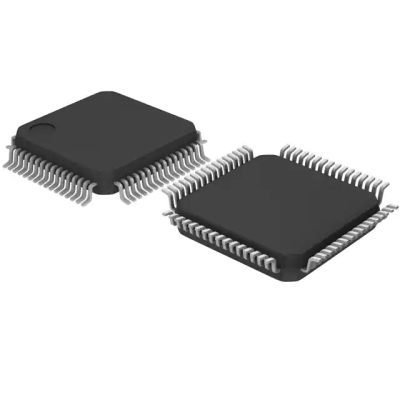AT89C51ED2-RDTUM
Part Number: AT89C51ED2-RDTUM
Manufacturer: Microchip Technology / Atmel
Description: 8-bit Microcontrollers – MCU 64kB Flash 2048B RAM 2.7V-5.5V
Shipped from: Shenzhen/HK Warehouse
Stock Available: Check with us
ICRFQ.com - Electronic Components Distributor in China Since 2003

Part Number: AT89C51ED2-RDTUM
Manufacturer: Microchip Technology / Atmel
Description: 8-bit Microcontrollers – MCU 64kB Flash 2048B RAM 2.7V-5.5V
Shipped from: Shenzhen/HK Warehouse
Stock Available: Check with us
| Datasheet | |
|---|---|
| Category | Integrated Circuits (ICs) |
| Family | Embedded – Microcontrollers |
| Manufacturer | Atmel |
| Series | 89C |
| Packaging | Tray |
| Part Status | Active |
| Core Processor | 80C51 |
| Core Size | 8-Bit |
| Speed | 60MHz |
| Connectivity | SPI, UART/USART |
| Peripherals | POR, PWM, WDT |
| Number of I/O | 50 |
| Program Memory Size | 64KB (64K x 8) |
| Program Memory Type | FLASH |
| EEPROM Size | 2K x 8 |
| RAM Size | 2K x 8 |
| Voltage – Supply (Vcc/Vdd) | 2.7 V ~ 5.5 V |
| Data Converters | – |
| Oscillator Type | External |
| Operating Temperature | -40°C ~ 85°C (TA) |
| Package / Case | 64-LQFP |
| Supplier Device Package | 64-VQFP (10×10) |
One such high-performance CMOS Flash 8-bit microcontroller is the AT89C51ED2-RDTUM.
It is based on the 80C51. Code and data are stored in a 64-KiByte Flash memory block. Software or an ISP can be used to rewrite the contents of the 64-Kbyte Flash memory in either parallel or serial mode. The standard VCC pin is used to create the programming voltage inside. Internal RAM of 256 bytes, a 9-source 4-level interrupt controller, and three timer/counters are carried over from the Microchip 80C52 to the AT89C51RD2/ED2.
The AT89C51ED2 has 2048 bytes of EEPROM for storing information that can be accessed even if the power is cut.
In addition, the AT89C51ED2-RDTUM comes with a Keyboard, SPI interface, Programmable Counter Array, 1792 bytes of XRAM, a Hardware Watchdog Timer, and a more flexible serial channel that supports multiprocessor communication (EUART), as well as a speed increase mechanism (X2 Mode). Bringing the clock frequency down to any value, including DC, without data loss is possible thanks to the static design of the AT89C51ED2-RDTUM.
The AT89C51ED2-RDTUM contains an 8-bit clockprescaler and two power-saving modes that may be selected in software to significantly lower power consumption. While the central processing unit is idle, the peripherals and interrupt system continue functioning normally. The power-down mode saves RAM and disables all other features. The AT89C51RD2/ED2 is a more robust option for applications like alarms, corded phones, motor control, and smart card readers that require pulse width modulation, high-speed I/O, and counting capabilities.
It is 80C52 Compatible
| Product Attribute | Attribute Value |
| Manufacturer: | Microchip |
| Product Category: | 8-bit Microcontrollers – MCU |
| RoHS: | Details |
| Series: | 89C |
| Mounting Style: | SMD/SMT |
| Package/Case: | VQFP-64 |
| Core: | 80C51 |
| Program Memory Size: | 64 kB |
| Data Bus Width: | 8 bit |
| ADC Resolution: | No ADC |
| Maximum Clock Frequency: | 60 MHz |
| The number of I/Os: | 50 I/O |
| Data RAM Size: | 2 kB |
| Supply Voltage – Min: | 2.7 V |
| Supply Voltage – Max: | 5.5 V |
| Minimum Operating Temperature: | – 40 C |
| Maximum Operating Temperature: | + 85 C |
| Packaging: | Tray |
| Brand: | Microchip Technology / Atmel |
| Height: | 1.45 mm |
| Interface Type: | SPI, UART |
| Length: | 10.1 mm |
| Moisture Sensitive: | Yes |
| The number of Timers/Counters: | 3 Timer |
| Processor Series: | AT89x |
| Product: | MCU |
| Product Type: | 8-bit Microcontrollers – MCU |
| Program Memory Type: | Flash |
| Factory Pack Quantity: | 160 |
| Subcategory: | Microcontrollers – MCU |
| Width: | 10.1 mm |
| Unit Weight: | 1,687 g |
Integrated circuits (ICs), often known as chips or microchips, are typically constructed using a semiconductor technology known as complementary metal-oxide semiconductors (CMOS). MOSFET technology is the foundation upon which CMOS transistors are built. MOSFET stands for a metal-oxide-semiconductor field-effect transistor.
On a computer’s motherboard is a small amount of memory known as complementary metal-oxide-semiconductor (CMOS). This memory stores the Basic Input/Output System (BIOS) settings. The software saved on the memory chip located on the motherboard is called the BIOS.
The word “8-bit” most commonly refers to the bit-width of the CPU; hence, a microcontroller that is 8 bits wide will have a CPU that is 8 bits wide. This indicates that all of the internal operations are performed on 8-bit values, that the stored variables are in 8-bit blocks, and that the busses used to access the external inputs and outputs are also 8 bits.
This refers to the maximum data unit size a computer can process, often known as its “word size.” Because a 1-bit may take on either the value 1 or 0, it can store information in any of those states.
Thanks for reading. If you thought this post was interesting, feel free to look around the rest of our website for other content similar to what you just read. If you have any questions about the content of this article or any other article that can be found on our website, please feel free to leave them in the comment box below, and we will try our best to respond to them.
Contact us at ICRFQ, your leading electronic distributor of electronic components in china, if you want more information or wish to purchase the AT89C51ED2-RDTUM. We will ensure that you receive the best product at the best price possible.
WhatsApp us